The greatest battle of antiquity on the field of Kuru
Interestingly, the first mention of the epic of the war of the descendants of Bharata dates back to the IV. BC, whereas it was recorded only in the 5th - 4th centuries. AD, i.e. formed the Mahabharata for a whole millennium! As an epic monument, this work is unparalleled. However, it is also possible to learn a great deal about how weapons fought ancient Indo-Europeans, which had military equipment and armor.
Arjuna and Krishna go to battle. This is how Indians imagined it in the past.
So from it you can find out that there existed a battle formation called “shakata” (trolley), but in order to counteract it, the troops had to be arranged in order under the name “crown” (crane).
Judging by the composition of the mythical military unit of akshauhini, which included 21870 chariots, 21870 elephants, 65610 cavalry and 109350 foot soldiers, chariots, elephants, horsemen and infantry participated in the battles of that time. It is significant, however, that the chariots on this list are the first, and most of the heroes of the poem do not fight as horsemen or riding elephants, but standing on chariots and leading their troops.
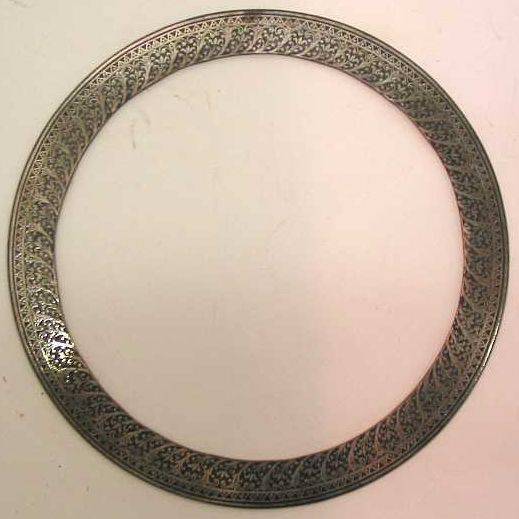
Here it is what chakra or chakras.
If we reject all sorts of artistic exaggerations and descriptions of the use of various kinds of "divine weapons", the most fantastic in their action, then for any researcher of this poem it will become obvious that the main place in her entire arsenal is occupied by bow and arrows. The convenience of using them for warriors fighting on chariots is obvious: one, standing on its platform, shoots, while the other rules the horses. In this case, the chariot often stands still, and the warrior hero on it sends clouds of arrows at the enemy. The poem describes that warriors do not disdain to kill horses harnessed to each other’s chariots and drivers. The chariot immobilized in this way becomes useless and then the warrior leaves it and rushes at the enemy with a sword and shield, or with a club, and, in extreme cases, having lost his weapon, he even grabs the wheel of the chariot and rushes into battle with him!
Various types of Indian edged weapons.
Of course, both of these warriors must have good training, since it is not so easy to control the chariot, especially in battle. Interestingly, the Pandava princes in the Mahabharata, demonstrating their dexterity in gun possession and riding, hit the targets with arrows at full gallop. That is, it speaks of their ability to ride and shoot a bow from this position - that is, the developed skills of horse archers. Then they show the ability to control chariots and ride on elephants, followed by archery again, and only in the very last turn they show their ability to fight with swords and clubs.
No weapons - the chariot wheel will do! The main thing for Abhimano - the son of Arjuna - to fight to the last!
Interestingly, if the bows of the heroes of the Western European epics are always nameless, but the names have swords and less often, the Vikings have axes, then the bows of the main characters of the Mahabharata, as a rule, have their own names. The bow of Arjuna, for example, is called Gandiva, and in addition to it, he has two never-ending quivers that are usually on his chariot, and the bow of Krishna is called Sharanga. They have their own names and other types of weapons and equipment: for example, the throwing disk of Krsna is called Sudarshana, the shell of Arjuna, the horn or pipe that replaced him is Devadatta, and the shell of Krsna is Panchajanya. Interestingly, the enemy of the Pandav princes, the son of the driver, Karna, possesses wonderful weapons — an irresistible dart that never misses, and he also has a proper name — Amodha. True, he can only be thrown once and Karna is forced to save him for a decisive duel with Arjuna, which, however, cannot enter and spends a dart on another opponent. But this is the only example when a proper name has a dart. Swords, which are used by pandavas and kauravs in a fight only after the arrows and other weapons have been used up, have no proper names. We emphasize once again that it was not so with the medieval knights of Europe, whose proper names had swords, but certainly not bows.
War chariot of Arjuna and Krishna. But they are even more spectacular in the Indian series from the 267 series.
To protect against enemy weapons, the warriors of the Mahabharata usually put on armor, have helmets on their heads and shields in their hands. In addition to bows - their most important weapon, they use spears, darts, and maces, which are used not only as impact weapons, but also for throwing, throwing discs - chakras and only the very last - swords.
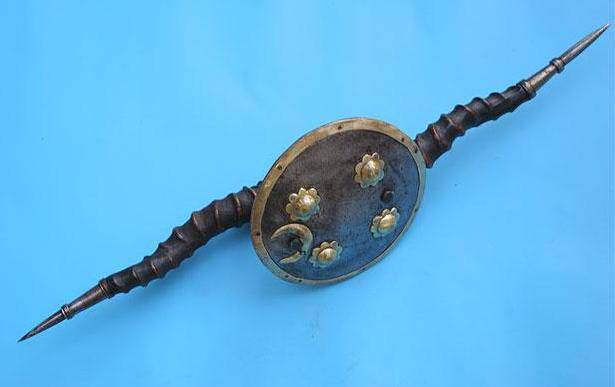
Antelope horns with metal tips and a shield.
Shooting from bows, standing on a chariot, the Pandava and Kaurava warriors use different types of arrows, and very often - arrows with crescent-shaped tips with which they cut bows of bows and bows themselves, in the hands of their opponents, cut them into pieces maces and enemy armor, as well as shields and even swords! The poem is literally filled with reports of whole streams of arrows, spewed by miracle shooters, as well as how they kill enemy elephants with their arrows, smash the chariots of war and repeatedly pierce each other. And it is indicative that not every pierced person is immediately killed, although someone happens to be hit with three, someone with five or seven, and someone with seven or ten arrows at once.
And the matter here is not only in the fabulousness of the plot of the Mahabharata. It’s just that in this case it’s just a hyperbolized display of the fact that many arrows, piercing the armor and even possibly stuck in them with their tips, couldn’t inflict serious wounds on the soldier himself. The warriors continued to fight, even if they were stuck with arrows that fell into them - the situation is also quite typical for the medieval era. In this case, the goal for enemy warriors, as already noted, was not only a warrior fighting in a chariot, but also his horses and a driver, who, although he participated in the battle, didn’t actually fight himself. It should be noted that many of the chariots operating in the poem adorn the banners, by which both their own and other people recognize them from afar. For example, the chariot of Arjuna had a banner with the image of the monkey god Hanuman, who at a difficult moment shouted loudly at his enemies, horrifying them, while the banner with a golden palm and three stars fluttered on the chariot of his mentor and opponent Bhishma.
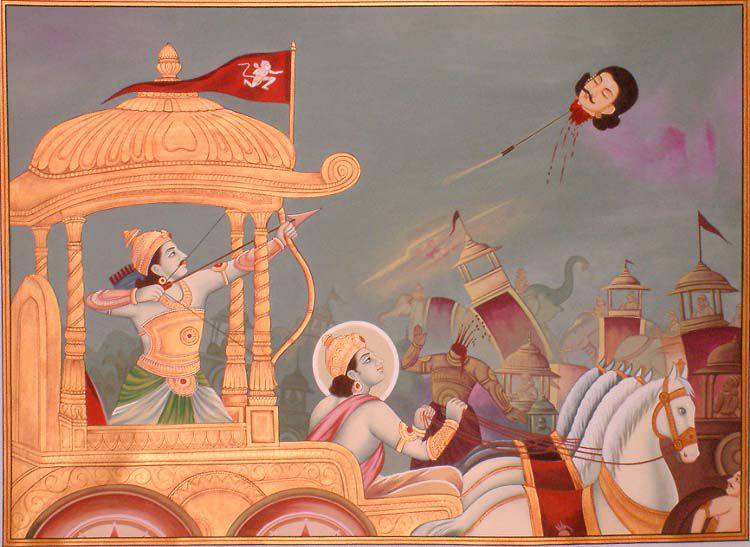
The Mahabharata is filled with truly amazing fantasies. For example, someone Vriddhakshatra swore his son Jayadrathu that if someone cut his head on the battlefield and she fell to the ground, then the head of the one who cut it down would immediately break into one hundred pieces! Here's how to kill this? But Arjuna finds a way out: his arrow carries the head of the killed son directly to the knees of the praying father Jayadrath, and when he rises (naturally without noticing anything around!) And the head falls to the ground, then ... what happens to him is what he himself invented ! What is it ?!
It is important to note that the heroes of the “Mahabharata” fight not only with bronze, but also with iron weapons, in particular - they use “iron arrows”. However, the latter, as well as all the fratricide taking place in the poem, is explained by the fact that by this time people had already entered the Kaliyuga, the “Iron Age” and the age of sin and vice, which began over three thousand years BC.
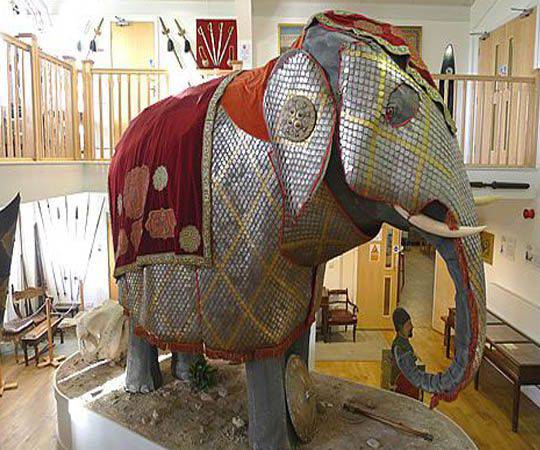
Indian war elephant in armor, XIX century Stratford Arms Museum, Stratford-upon-Ivan, England.
In the poem constantly some actions of her heroes are condemned as unworthy, others - on the contrary, demonstrate their nobility. “... Before he connected with Arjuna, Bhurishravas attacked him and showered him with arrows; and Satyaki showered with arrows Bhurishravasa, and both struck each other many times with powerful blows. Under the arrows of Bhurishravas Satyaki's horses fell, and Satyaki killed the enemy's horses with their arrows. Having lost horses, both heroes descended from chariots and rushed at each other with swords in their hands, bleeding like other two angry tigers. And they were cut for a long time, and neither could defeat the other, but finally, Satyaki, exhausted in the fight, began to give way. Seeing this, Krishna turned his chariot there and said to Arjuna: “Look, Bhurishravas will overcome, he will kill Satyaki if you don’t help him.” And when Bhurishravas plunged his opponent to the ground and raised a sword over him for the final blow, Arjuna quickly arrowed off the hero’s hand along with the sword. Bhurishravas stumbled and sank to the ground, losing strength. And, turning to Arjuna with a reproachful look, he said: “Oh mighty, you didn’t befell to interfere in our combat!” Meanwhile, Satyaki jumped to his feet and, picking up his sword, cut off their head to Bhurishravas, who was whispering prayers. But for this act, unworthy of an honest warrior, he was condemned by both Arjuna and Krishna, and other warriors who watched the duel with Bhurishravas. ”
Kalari Payatu - the oldest military art of India to fight with swords.
But even more interesting in the poem is a strange turn occurring with its heroes who entered the war. Thus, the positive heroes of peacetime, of course, are the noble Pandavas, and the Kauravas are shown by people of low moral qualities and cause universal condemnation.
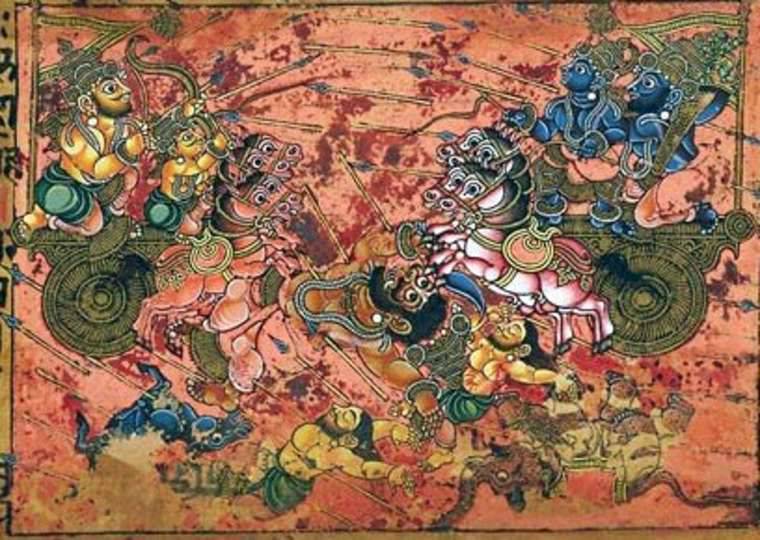
Karna kills Ghatotkachu. Ghatotkacha is a rakshash demon and should not interfere in human battles. But he is the son of one of the Pandavas. And when his father asks for help, he cannot refuse, although this is against the rules. “A righteous person can neglect the rules,” divine Krishna says to his father, “if he has a worthy goal!” That is, this is the idea: if the goal is noble, any action is justified!
However, when war breaks out, it is the Kauravas who fight quite honestly and nobly, while the Pandavas resort to various tricks and act in the most insidious manner. For example, the god and charioteer of Arjuna, Krishna, advises to undermine the morale of their opponent Drones falsely reporting the death of his son Ashwatthamana, so that later it would be easier to kill him. And they do it very cleverly. An elephant named Ashvatthaman is killed. And the most honest of the Pandavas informs Drona that he has been killed, but the elephant pronounces the word indistinctly. And he, of course, thinks about his son! Why is this in the poem? What did the ancient authors want to show in such a way that war corrupts and corrupts even the most noble? But what about the Kauravas, who are already "bad"?
Krishna and Arjuna blow the shells.
Or, as one of the scholars said, "pandavas are right and in their weaknesses, and the Kauravas are guilty in their valor." Or does it show that the main goal of the war is victory, and it will redeem everything? Then before us, probably, the most ancient substantiation of the principle “the end justifies the means”, expressed in the epic form! In the Mahabharata it is explicitly said that the winner is always right. He can even change karma, because it is in his power to change the idea of her!
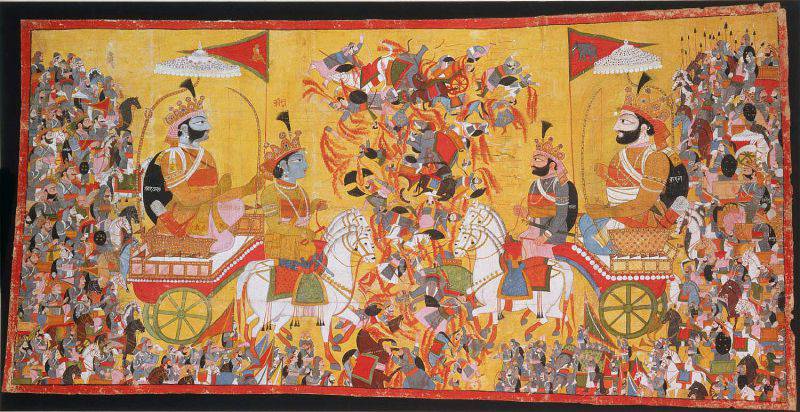
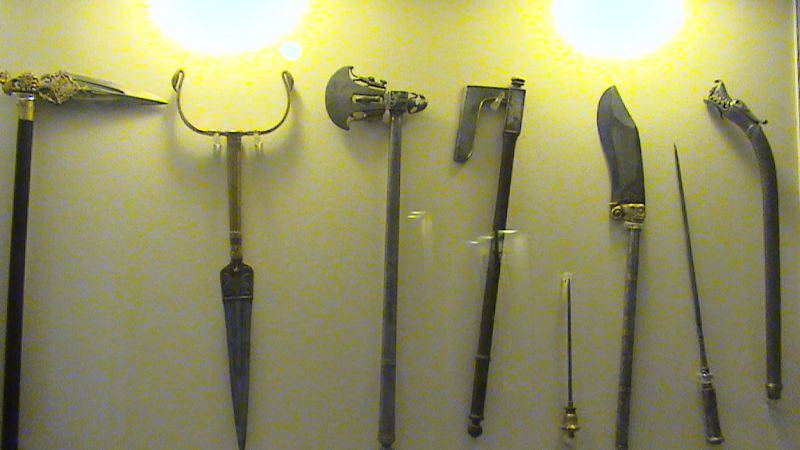
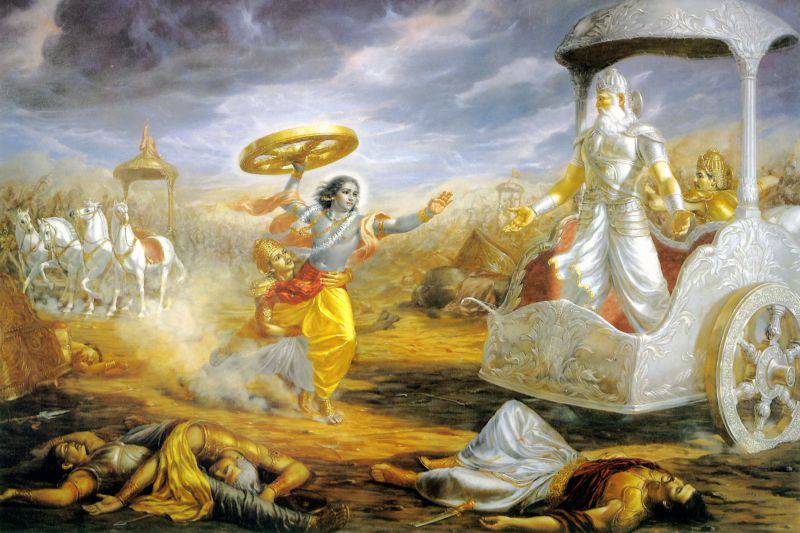
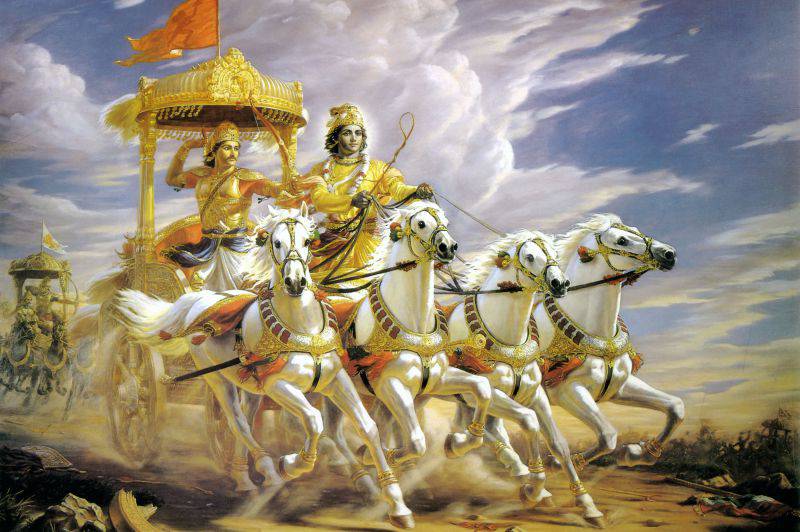
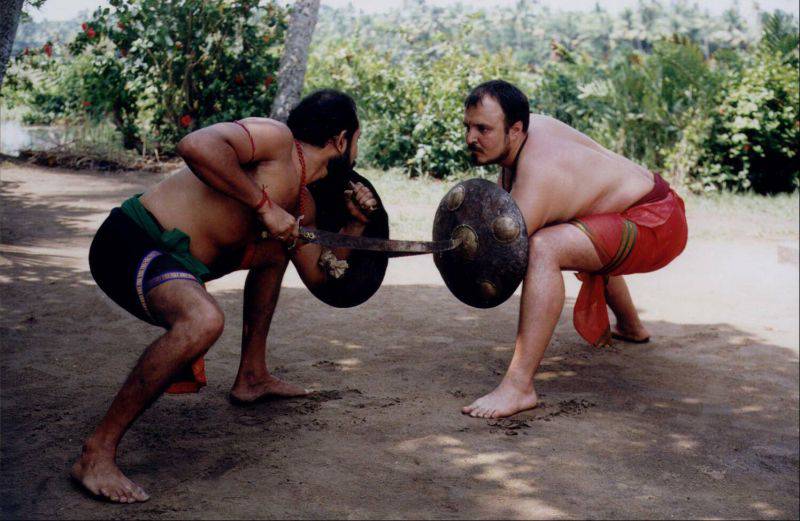
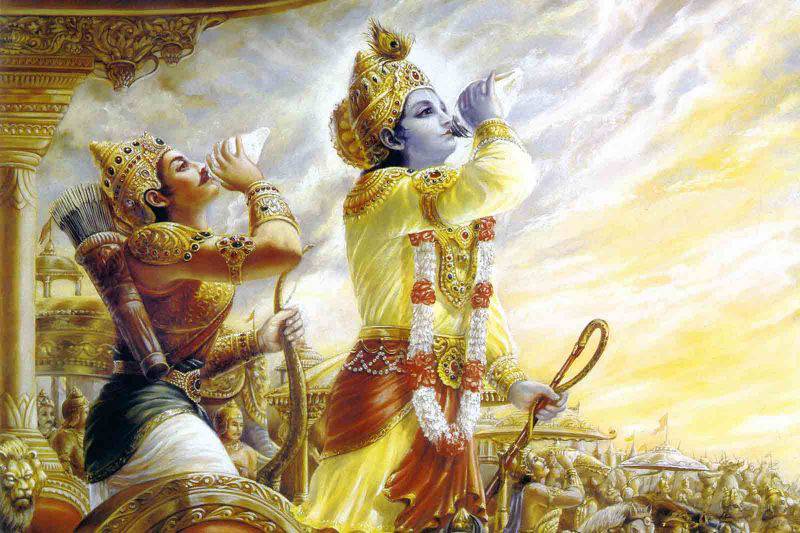
Information